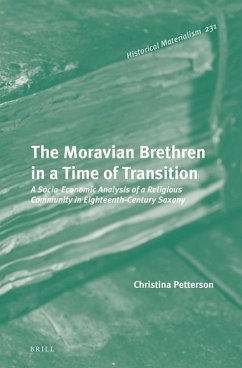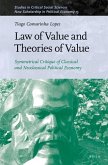Christina Petterson
The Moravian Brethren in a Time of Transition
A Socio-Economic Analysis of a Religious Community in Eighteenth-Century Saxony
Christina Petterson
The Moravian Brethren in a Time of Transition
A Socio-Economic Analysis of a Religious Community in Eighteenth-Century Saxony
- Gebundenes Buch
- Merkliste
- Auf die Merkliste
- Bewerten Bewerten
- Teilen
- Produkt teilen
- Produkterinnerung
- Produkterinnerung
In The Moravian Brethren in a Time of Transition Christina Petterson combines archival analysis with socio-economic change to demonstrate the importance of the Protestant sect, the Moravian Brethren, as an example of the reconfiguration of communities in early capitalism.
Andere Kunden interessierten sich auch für
![The History of the Public Revenue of the British Empire: Containing an Account of the Public Income and Expenditure From the Remotest Periods Recorded The History of the Public Revenue of the British Empire: Containing an Account of the Public Income and Expenditure From the Remotest Periods Recorded]() John SinclairThe History of the Public Revenue of the British Empire: Containing an Account of the Public Income and Expenditure From the Remotest Periods Recorded39,99 €
John SinclairThe History of the Public Revenue of the British Empire: Containing an Account of the Public Income and Expenditure From the Remotest Periods Recorded39,99 €![Global Labour in the Fourth Industrial Revolution Global Labour in the Fourth Industrial Revolution]() Adrián Sotelo ValenciaGlobal Labour in the Fourth Industrial Revolution137,99 €
Adrián Sotelo ValenciaGlobal Labour in the Fourth Industrial Revolution137,99 €![Russia in the Context of Global Transformations Russia in the Context of Global Transformations]() Aleksandr BuzgalinRussia in the Context of Global Transformations223,99 €
Aleksandr BuzgalinRussia in the Context of Global Transformations223,99 €![Towards a Productive Aesthetics Towards a Productive Aesthetics]() Keith O'ReganTowards a Productive Aesthetics140,99 €
Keith O'ReganTowards a Productive Aesthetics140,99 €![Law of Value and Theories of Value Law of Value and Theories of Value]() Tiago Camarinha LopesLaw of Value and Theories of Value165,99 €
Tiago Camarinha LopesLaw of Value and Theories of Value165,99 €![Agrarian History of the Cuban Revolution Agrarian History of the Cuban Revolution]() Joana Salém VasconcelosAgrarian History of the Cuban Revolution183,99 €
Joana Salém VasconcelosAgrarian History of the Cuban Revolution183,99 €![Reading Capital's Materialist Dialectic Reading Capital's Materialist Dialectic]() Nick NesbittReading Capital's Materialist Dialectic106,99 €
Nick NesbittReading Capital's Materialist Dialectic106,99 €-
-
-
In The Moravian Brethren in a Time of Transition Christina Petterson combines archival analysis with socio-economic change to demonstrate the importance of the Protestant sect, the Moravian Brethren, as an example of the reconfiguration of communities in early capitalism.
Produktdetails
- Produktdetails
- Verlag: Brill
- Seitenzahl: 392
- Erscheinungstermin: 16. September 2021
- Englisch
- Gewicht: 775g
- ISBN-13: 9789004319462
- ISBN-10: 9004319468
- Artikelnr.: 62311472
- Herstellerkennzeichnung
- Libri GmbH
- Europaallee 1
- 36244 Bad Hersfeld
- gpsr@libri.de
- Verlag: Brill
- Seitenzahl: 392
- Erscheinungstermin: 16. September 2021
- Englisch
- Gewicht: 775g
- ISBN-13: 9789004319462
- ISBN-10: 9004319468
- Artikelnr.: 62311472
- Herstellerkennzeichnung
- Libri GmbH
- Europaallee 1
- 36244 Bad Hersfeld
- gpsr@libri.de
Christina Petterson, PhD (2011, Macquarie University), is visiting research fellow at the Australian National University, School of Politics. She has published extensively on Christianity and socio-economics, and most recently co-edited Legacies of David Cranz' Historie von Grönland (Palgrave Macmillan, 2021).
Preface and Acknowledgements
Introductions
1 To the Marxists
2 To Moravian Scholars and Other Theologians
3 Outline of Chapters
1 Introducing Choir Ideology
1 Introduction
2 From Choir Speech to Choir Ideology
3 What Is the Function of a Choir?
4 Methodology
5 The Choirs as Vanishing Mediators
2 The Choirs – A Genealogy
1 Introduction
2 Overview of the Genealogy
3 Terminology and the Establishment of the Choirs
4 The Day of All Choirs: 25 March
5 Choir Houses
6 Conclusion
3 Blood, Wounds, and Class
1 Introduction
2 Martin Dober’s Account
3 The Purge in Herrnhut
4 Blood, Wounds, and Authority
5 Conclusion
4 The Choir Speeches
1 Introduction
2 The Saviour, Individual and Collective
3 Children’s Choir
4 Boys’ Choir
5 Girls’ Choir
6 Single Brothers’ Choir
7 Single Sisters’ Choir
8 Widowers’ Choir
9 Widows’ Choir
10 Conclusion
5 Marriage and Community
1 Zinzendorf’s Idea of Marriage
2 The Problem
3 After the Synod
4 Conclusion
6 The State and Its Subjects
1 Stand as Manifestation of Cultural Revolution
2 Gender
3 Class Society and the Civic Self
4 Individual and Subject
5 The Question of Religion
6 Conclusion
7 Horizons of History
1 Times of Change
2 Agents of Change or Expressions of Change
3 Dimensions of History
Appendix 1
Appendix 2
References
Index
Introductions
1 To the Marxists
2 To Moravian Scholars and Other Theologians
3 Outline of Chapters
1 Introducing Choir Ideology
1 Introduction
2 From Choir Speech to Choir Ideology
3 What Is the Function of a Choir?
4 Methodology
5 The Choirs as Vanishing Mediators
2 The Choirs – A Genealogy
1 Introduction
2 Overview of the Genealogy
3 Terminology and the Establishment of the Choirs
4 The Day of All Choirs: 25 March
5 Choir Houses
6 Conclusion
3 Blood, Wounds, and Class
1 Introduction
2 Martin Dober’s Account
3 The Purge in Herrnhut
4 Blood, Wounds, and Authority
5 Conclusion
4 The Choir Speeches
1 Introduction
2 The Saviour, Individual and Collective
3 Children’s Choir
4 Boys’ Choir
5 Girls’ Choir
6 Single Brothers’ Choir
7 Single Sisters’ Choir
8 Widowers’ Choir
9 Widows’ Choir
10 Conclusion
5 Marriage and Community
1 Zinzendorf’s Idea of Marriage
2 The Problem
3 After the Synod
4 Conclusion
6 The State and Its Subjects
1 Stand as Manifestation of Cultural Revolution
2 Gender
3 Class Society and the Civic Self
4 Individual and Subject
5 The Question of Religion
6 Conclusion
7 Horizons of History
1 Times of Change
2 Agents of Change or Expressions of Change
3 Dimensions of History
Appendix 1
Appendix 2
References
Index
Preface and Acknowledgements
Introductions
1 To the Marxists
2 To Moravian Scholars and Other Theologians
3 Outline of Chapters
1 Introducing Choir Ideology
1 Introduction
2 From Choir Speech to Choir Ideology
3 What Is the Function of a Choir?
4 Methodology
5 The Choirs as Vanishing Mediators
2 The Choirs – A Genealogy
1 Introduction
2 Overview of the Genealogy
3 Terminology and the Establishment of the Choirs
4 The Day of All Choirs: 25 March
5 Choir Houses
6 Conclusion
3 Blood, Wounds, and Class
1 Introduction
2 Martin Dober’s Account
3 The Purge in Herrnhut
4 Blood, Wounds, and Authority
5 Conclusion
4 The Choir Speeches
1 Introduction
2 The Saviour, Individual and Collective
3 Children’s Choir
4 Boys’ Choir
5 Girls’ Choir
6 Single Brothers’ Choir
7 Single Sisters’ Choir
8 Widowers’ Choir
9 Widows’ Choir
10 Conclusion
5 Marriage and Community
1 Zinzendorf’s Idea of Marriage
2 The Problem
3 After the Synod
4 Conclusion
6 The State and Its Subjects
1 Stand as Manifestation of Cultural Revolution
2 Gender
3 Class Society and the Civic Self
4 Individual and Subject
5 The Question of Religion
6 Conclusion
7 Horizons of History
1 Times of Change
2 Agents of Change or Expressions of Change
3 Dimensions of History
Appendix 1
Appendix 2
References
Index
Introductions
1 To the Marxists
2 To Moravian Scholars and Other Theologians
3 Outline of Chapters
1 Introducing Choir Ideology
1 Introduction
2 From Choir Speech to Choir Ideology
3 What Is the Function of a Choir?
4 Methodology
5 The Choirs as Vanishing Mediators
2 The Choirs – A Genealogy
1 Introduction
2 Overview of the Genealogy
3 Terminology and the Establishment of the Choirs
4 The Day of All Choirs: 25 March
5 Choir Houses
6 Conclusion
3 Blood, Wounds, and Class
1 Introduction
2 Martin Dober’s Account
3 The Purge in Herrnhut
4 Blood, Wounds, and Authority
5 Conclusion
4 The Choir Speeches
1 Introduction
2 The Saviour, Individual and Collective
3 Children’s Choir
4 Boys’ Choir
5 Girls’ Choir
6 Single Brothers’ Choir
7 Single Sisters’ Choir
8 Widowers’ Choir
9 Widows’ Choir
10 Conclusion
5 Marriage and Community
1 Zinzendorf’s Idea of Marriage
2 The Problem
3 After the Synod
4 Conclusion
6 The State and Its Subjects
1 Stand as Manifestation of Cultural Revolution
2 Gender
3 Class Society and the Civic Self
4 Individual and Subject
5 The Question of Religion
6 Conclusion
7 Horizons of History
1 Times of Change
2 Agents of Change or Expressions of Change
3 Dimensions of History
Appendix 1
Appendix 2
References
Index








